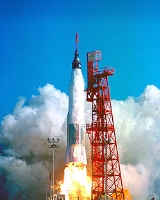
SM-65D Atlas
Encyclopedia
The SM-65D Atlas, or Atlas D, was the first operational version of the U.S. Atlas missile. It first flew on April 14, 1959. Atlas D missiles were also used for orbit
al launches, both with upper stages and on their own as a stage-and-a-half vehicle.
Atlas D launches were conducted from Cape Canaveral Air Force Station
, at Launch Complexes 11
, 12
, 13
and 14
, and Vandenberg Air Force Base
at Launch Complex 576.
Most Atlas D launches were sub-orbital missile tests; however several were used for other missions, including orbital launches of manned Mercury, and unmanned OV1 spacecraft. Two were also used as sounding rocket
s as part of Project FIRE. A number were also used with upper stages, such as the RM-81 Agena
, to launch satellites.
For Mercury, the Atlas D was used to launch four manned
Mercury spacecraft into low Earth orbit
. The modified version of the Atlas D used for Project Mercury was designated Atlas LV-3B
.
Orbit
In physics, an orbit is the gravitationally curved path of an object around a point in space, for example the orbit of a planet around the center of a star system, such as the Solar System...
al launches, both with upper stages and on their own as a stage-and-a-half vehicle.
Atlas D launches were conducted from Cape Canaveral Air Force Station
Cape Canaveral Air Force Station
Cape Canaveral Air Force Station is an installation of the United States Air Force Space Command's 45th Space Wing, headquartered at nearby Patrick Air Force Base. Located on Cape Canaveral in the state of Florida, CCAFS is the primary launch head of America's Eastern Range with four launch pads...
, at Launch Complexes 11
Cape Canaveral Air Force Station Launch Complex 11
Launch Complex 11 at Cape Canaveral Air Force Station, Florida, is a launch complex used by Atlas missiles between 1958 and 1964. It is the southernmost of the launch pads known as missile row...
, 12
Cape Canaveral Air Force Station Launch Complex 12
Launch Complex 12 at Cape Canaveral Air Force Station, Florida is a launch pad used by Atlas rockets and missiles between 1958 and 1967. It is the second-most southern of the pads known as missile row, between LC-11 to the south and LC-13 to the north...
, 13
Cape Canaveral Air Force Station Launch Complex 13
Launch Complex 13 at Cape Canaveral Air Force Station, Florida is a deactivated launch complex used by Atlas rockets and missiles between 1958 and 1978. It is the third-most southern of the complexes known as missile row, between LC-12 and LC-14...
and 14
Cape Canaveral Air Force Station Launch Complex 14
Launch Complex 14 is a launch site at Cape Canaveral Air Force Station, Florida. LC-14 was used for various manned and unmanned Atlas launches, including the Friendship 7 flight aboard which John Glenn became the first American to orbit the Earth....
, and Vandenberg Air Force Base
Vandenberg Air Force Base
Vandenberg Air Force Base is a United States Air Force Base, located approximately northwest of Lompoc, California. It is under the jurisdiction of the 30th Space Wing, Air Force Space Command ....
at Launch Complex 576.
Most Atlas D launches were sub-orbital missile tests; however several were used for other missions, including orbital launches of manned Mercury, and unmanned OV1 spacecraft. Two were also used as sounding rocket
Sounding rocket
A sounding rocket, sometimes called a research rocket, is an instrument-carrying rocket designed to take measurements and perform scientific experiments during its sub-orbital flight. The origin of the term comes from nautical vocabulary, where to sound is to throw a weighted line from a ship into...
s as part of Project FIRE. A number were also used with upper stages, such as the RM-81 Agena
RM-81 Agena
The RM-81 Agena was an American rocket upper stage and satellite support bus which was developed by Lockheed initially for the canceled WS-117L reconnaissance satellite program...
, to launch satellites.
For Mercury, the Atlas D was used to launch four manned
Human spaceflight
Human spaceflight is spaceflight with humans on the spacecraft. When a spacecraft is manned, it can be piloted directly, as opposed to machine or robotic space probes and remotely-controlled satellites....
Mercury spacecraft into low Earth orbit
Low Earth orbit
A low Earth orbit is generally defined as an orbit within the locus extending from the Earth’s surface up to an altitude of 2,000 km...
. The modified version of the Atlas D used for Project Mercury was designated Atlas LV-3B
Atlas LV-3B
The Atlas LV-3B, Atlas D Mercury Launch Vehicle or Mercury-Atlas Launch Vehicle, was a man-rated expendable launch system used as part of the United States Project Mercury to send astronauts into low Earth orbit. It was derived from the SM-65D Atlas missile, and was a member of the Atlas family of...
.

